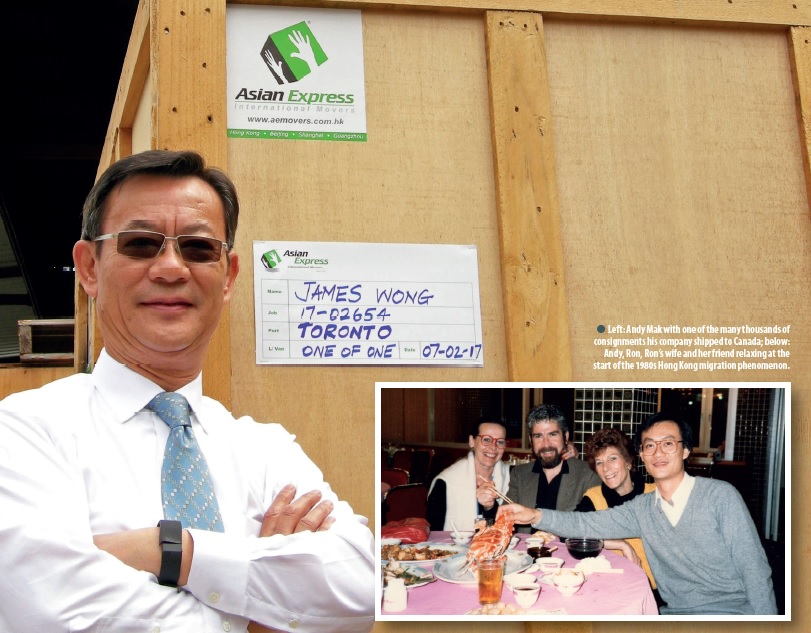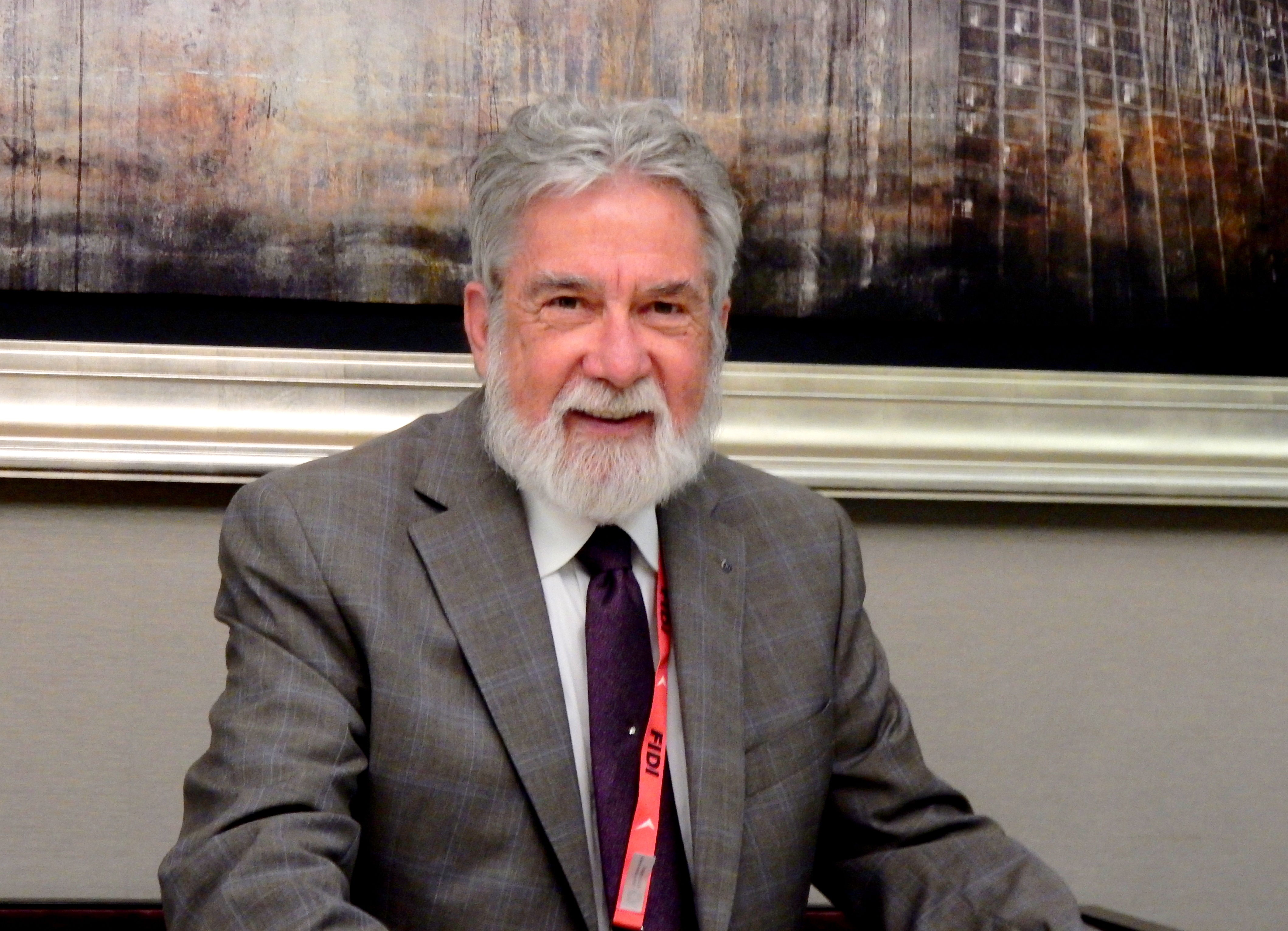In April we featured a story about how Andy Mak of Asian Express in Hong Kong became the father of Hong Kong groupage. Here, Steve Jordan talks to Ron Waddling, Director of International Business for Tippet Richardson in Canada, who explains the story from the other side of the world, and has a salient message for us all.

It was in a quiet moment, just before dinner, that I sat down with Ron Waddling in a corner of the bar of the JW Marriott in Dubai, while the FIDI conference was in full swing around us. I hadn’t seen him for many years (except very briefly in Geneva last year) but he hadn’t changed much: still dapper, bearded and with his gentle, hypnotic, Canadian accent that makes you want to listen to every word. He really should have been a news announcer with a voice like that.
 Ron told me of a time, back in the 1980s, when he first met Andy Mak of Asian Express in Hong Kong and a new chapter in his company’s history began. He’d become interested in the increasing movement of people from Hong Kong to Canada. Britain was due to return Hong Kong to Chinese administration in 1997 and it was clear that the locals were becoming restless. It was only 30+ years since the end of the war and many Hong Kong Chinese remembered all too clearly the resistance against the Japanese and the rise of the subsequent communist regime. Their anxiety was understandable.
Ron told me of a time, back in the 1980s, when he first met Andy Mak of Asian Express in Hong Kong and a new chapter in his company’s history began. He’d become interested in the increasing movement of people from Hong Kong to Canada. Britain was due to return Hong Kong to Chinese administration in 1997 and it was clear that the locals were becoming restless. It was only 30+ years since the end of the war and many Hong Kong Chinese remembered all too clearly the resistance against the Japanese and the rise of the subsequent communist regime. Their anxiety was understandable.
He had done some research at home and found that the Canadian government, under Liberal Prime Minister Pierre Trudeau, was sympathetic to the prospect of accepting immigrants from Hong Kong. It seemed to Ron that the circumstances were stacking up to create more than just a few household goods movements from the disaffected. This was an impending mass migration.
So, armed with a pocked full of facts, his company presentation and a professionally produced video about life in Canada, Ron headed east on his own, one-man diplomatic mission. Tippet Richardson had, at that time, a very close working relationship with Pickfords so his first call (he expected it to be his only call) was to the company’s office in Hong Kong. “But they were not really interested,” said Ron. “Maybe they felt that the people who were leaving wouldn’t have much to ship and, anyway, as one of the only household goods shippers in Hong Kong, they would get their share of the traffic without making a special effort.” Ron tried Crown too, but got a similar reaction. He was perplexed.
At home Ron was a member of The Rotary Club. It was mandatory for Rotary members to attend meetings so Ron looked up the local club and went along. “I was probably looking a little depressed when a man came over to speak to me,” said Ron. “He asked where I was from and I told him my tale of woe. He asked, 'Have you spoken to Andy Mak?' I explained that I had never heard of him, so the stranger promised to arrange a meeting. To this day I have no idea who this man was.” Andy, of course, having just started his company, was not a member of FIDI or any other association so was somewhat hidden from view.
Ron went along to see Andy who was, at that time, operating from a modest building. “I thought he might have one or two containers,” said Ron, “so we discussed how much we would charge to handle the destination services for them. I showed him my briefcase of marketing support tools and explained what I thought would happen as the corridors for migrants to Canada began to open up. He listened carefully to my pitch and appeared very open minded. Then he said: ‘If you can handle two containers, can you handle these?’ He produced an armful of files, there must have been 100, and said there were plenty more on the way.” It became clear to Ron that the mass migration he had predicted had already started, and Andy’s company was right at the sharp end. “I was blown away by it,” said Ron. “I couldn’t wait to get back to the hotel to tell the office.”
And so it began. Ron went back to Toronto and told his traffic people to gear up for the extra work. Just as Andy had promised, they came, in their thousands. “They spread all across Canada,” said Ron. “The government wanted them to settle in the more remote areas, not in the cities. There were incentives to move outside of urban areas which raised the opportunity for entry permits. I remember that Fort McMurray in Alberta was very popular. It’s now in the prosperous oil-tar sands area. They would buy a restaurant, run it for a while then sell it to a friend in Hong Kong who would also use it as a means of getting to Canada. We moved people to the same place a few times.”
Canada gave a warm welcome to these people, many of whom were frightened about what the future held in their own countries, but were not poor. They were quite wealthy, often buying in well-to-do areas in Canada. If they didn’t move all their household goods immediately, they soon did when they found somewhere to live and settled down. “I told Peter Naylor, Tippet’s president and owner, that we would have to get some Chinese staff, which we did. That helped make them feel welcome. We’d also go with them to clear their goods through customs, just for support. We call ourselves ‘The friendly movers’, so that’s what we tried to be for them.”
The Canadian government required the Chinese immigrants in one category to have a minimum of C$250,000. In many cases mum and the kids moved to Canada leaving dad in Hong Kong to continue running the business. The migration route continued throughout the 1980s and 1990s and beyond 1997 until the present day. In 2001 over 230,000 Hong Kong Chinese entered Canada as immigrants, by 2011 that figure had dropped, but not much, to around 200,000. Today, Chinese people in Canada have integrated into the society with many of them taking high office as councillors or members of parliament.
The movements of people and goods from Hong Kong to Canada has not stopped and, interestingly, might be on the rise again. Justin Trudeau is now Prime Minister of Canada, a Liberal like his father and apparently welcoming to immigrants. At the same time the good people of Hong Kong remain uneasy with well-documented demonstrations on the streets last year.
In itself, this is an interesting tale, but there’s much more to it than historical curiosity. We live in an unstable world, probably more so than at any time in the last 80 years. Where might the next Hong Kong be? When Ron first started investigating his government’s attitude to migrants it was time consuming and complex. Now it’s easy – we have the Internet. The displaced people of Syria are not all destitute. Many of them have already left with what they could carry but, when they find a safe and secure home they will, inevitably, become valued members of the community and want to set up home. The same may well be true of the north Africans or eastern Europeans. Who will help them? Where are the opportunities? You just need to look.
The Hong Kong history proves that this is not a momentary bubble. It’s been going on there since the early 1980s and is continuing now with children of migrants, having Canadian citizenship, returning home, probably temporarily, and the fathers, now retired, joining their families in their adopted country.
This is how migration trends start and flourish. Brits are still moving to Australia long after the ten-pound Pom programme stopped. This is long-term business. “They might be only coming with a couple of suitcases this time around,” said Ron. “But they could be a couple of suitcases of money and there’s much more to follow. You just have to believe in them, help them and be a little patient.”
Click here to see the next Editor's Pick